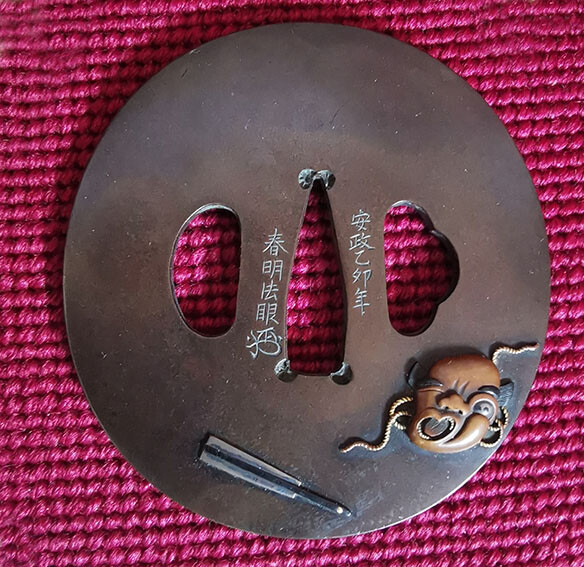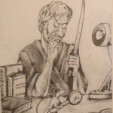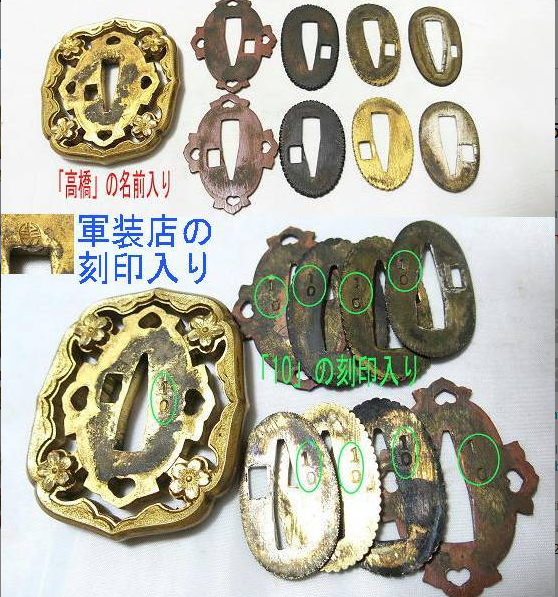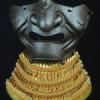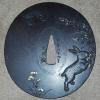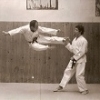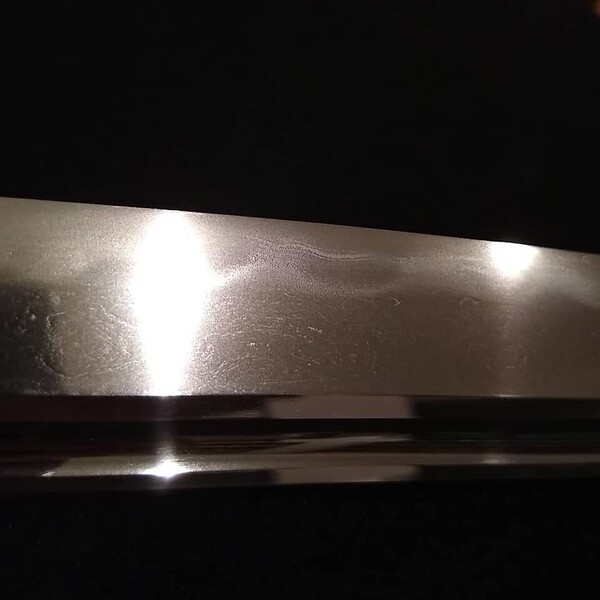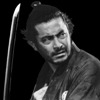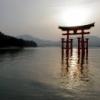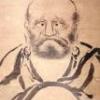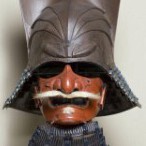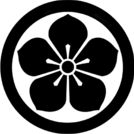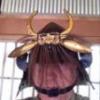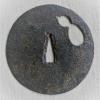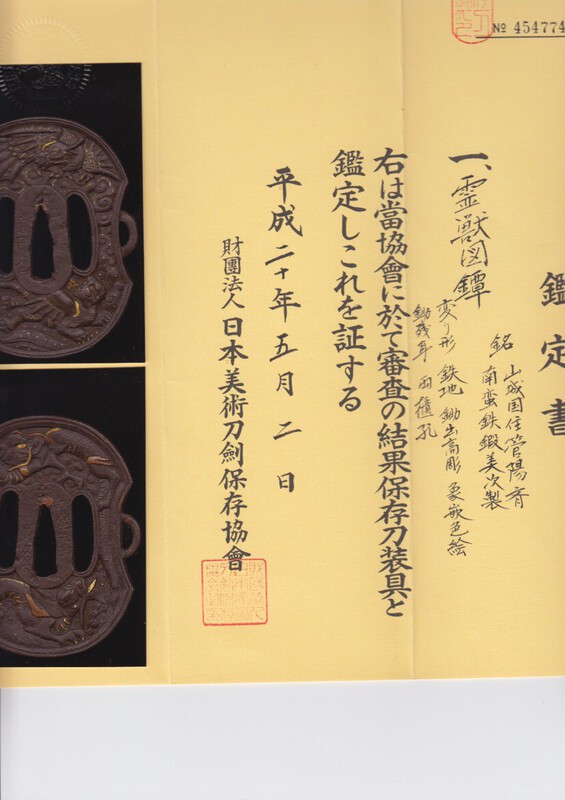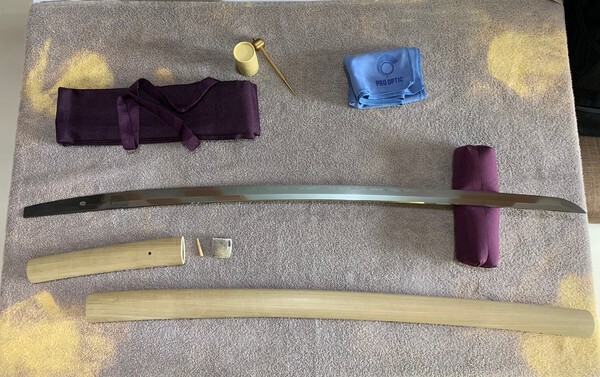Leaderboard
Popular Content
Showing content with the highest reputation on 05/01/2021 in all areas
-
Today I drove down to Kamakura to visit my friend Robert Hughes (well, being one of those jaded, elitist nihontō pricks, I don’t have any real friends, but Bob is the next best thing). After some hearty lunch next to a beautifully maintained Japanese garden we strolled to the Hongakuji Temple (本覚寺) of the Nichiren sect (日蓮宗). Ashikaga Mochiuji (足利持氏) built, and then donated, this temple to the priest Nisshutsu (日出) on the site where Nichiren stayed at after returning from his exile to Sado (佐渡島); the temple houses some of the ashes of Nichiren. A stone monument stands near the main temple in honor of Okazaki Gorō Masamune (岡崎五郎正宗). The story goes that when Okazaki Gorō, still a boy, came to Kamakura, Nichiren had already taken up residence in the Ebisudō (夷堂) Hall. Gorō 's father brought him to Nichiren to learn his teachings, and in return Nichiren gave the boy a new name, Masamune - which implies the rightness of the teachings of Nichiren himself. Nearby is a prayer column dedicated to Masamune, dating from the Muromachi period and finally there are the gravestones of Masamune and his son Sadamune; they date from the Nambokuchō period, and all inscriptions are eroded. To be fair, there are (yet) no hard facts or documents to support all this, only circumstantial evidence. Further research is needed to corroborate all of this. *** See, Bob, you censuring me for taking photos while you explained all this to me was totally uncalled for – I actually *can* multitask! Oh, and if I got something wrong, it’s only because you didn’t explain it correctly.9 points
-
What a great afternoon! I spent many a day here when I lived in Kamakura - actually the Kamakura Branch of the NBTHK holds their monthly meetings at this very temple, so we were literally studying at the foot of the great master. I would like to make some small additions to the information. The large stone that Guido is standing in front of is from the Edo period - it was dedicated by a collection of sword dealers, who owed their prosperity to his excellence (Masamune not Guido). If you were to look closely at the square stone at waist height on Guido, the names of all those who donated to have the stone erected are inscribed there but the years have nearly worn them away. The grave where Bob is standing is the grave of Masamune. As Guido pointed out Masamune can also be read Seiso and means "true teaching" however he got the name he was a devotee of the true teaching of Nichiren. The very ancient pair of graves in the last photos are held to be the family graves of the Yamamura Family, so may include Sadamune and other early members of the school (family). Incidentally Yamamura Sensei still practices sword craft in Kamakura as the 24th generation Masamune, Yamamura Tsunahiro. Kamakura is absolutely the place to visit for anyone interested in the sword, Bob is very lucky to make his home there taxes or no... -t7 points
-
I know there have been discussions on the topic and I hope my example here is not taken wrongly. I was thinking what type of title I would choose, decided to go with this one. As there was a good attribution thread that featured Yamashiro and it's influences I thought I could post this. This gets into very high level territory and I am not nearly proficient enough to say anything of note regards it. As a disclaimer do not think similar thing will happen to you if are submitting/resubmitting an item. I just thought this would be fun to post and possibly create some discussion in positive sense. Here in left the mumei sword passed Jūyō 21 and was attributed as Enju (延寿) then later on the mumei sword passed Tokubetsu Jūyō 6 and the attribution was now den Awataguchi Kuniyoshi (伝粟田口国吉) Of course this is very complicated matter and there are no easy answers. I know we often talk about Enju being close to Rai but on great pieces the gap is most likely quite small. I must confess I am not a quality oriented nihontō enthusiast but I do feel it is important try to understand the quality. This most likely very nice sword got first attributed as Enju and then with more throughout Tokujū shinsa it got "upgraded" to den Awataguchi Kuniyoshi. Note that I am using the word upgrade bit tongue in cheeck in here. I know many people think Enju as maybe lower high tier - upper mid tier attribution below Awataguchi & Rai. While not as prestegious as the others mentioned Enju school had multiple historically important smiths that produced high level work. Also to be noted in the end it is the same sword... Regardless of the attribution it must be very nice mumei sword. I guess what I was kind of aiming at is that there is much more to the items that just the attribution. While commercially some attributions are very desirable, I feel they carry slightly less weight when trying to just study. Still I have to bow my own head down as I feel I am very easily influenced by attributions as my own level of understanding is lacking. At first I had trouble locating the counterpart for this TokuJū from the Jūyō items. So I had to go what I considered as logical Yamashiro route, first all of mumei Awataguchi -> mumei Rai -> mumei Enju. Unfortunately I cannot really put the few thoughts I have on this subject in easy to understand form but I was kinda just aiming to kick off a conversation starter.5 points
-
I can only speak to my personal experience: I've papered >100 blades, probably closer to 200 swords (did not count in any formal way). Of those re-papered (with different or same organization) something between 40 and 60. It has to be admitted that in all repapering cases I had doubts about the original attribution. These were with very few exceptions mumei blades, so I'll talk about those, with fully readable signature its just a whole different game. NONE papered to the same name. Exactly zero out of 50 or so. Including blades with half intact signatures. Most papered to the same school (i.e. Bizen, Soshu, Yamato etc.) if one accepts a more inclusive definition (i.e. Nio is Yamato, Unju is either Bizen or Yamato etc. etc.). There was no clear preference in terms of any particular shinsa team giving more favorable judgements. I had two decent Juyo repapered by NTHK-NPO to lesser names and with respective scores of 75 and 76, i.e. just "average-good" in their opinion. There was a significant spread in terms of name recognition. O-Kanemitsu and a much lesser name, almost Kozori-class - but in all honesty not that different in terms of either time or work style. The worst game is Soshu. Basically every high class tanto with late Muromachi/also late Nambokucho sugata had 50% chance to draw Shimada Yoshisuke or other Shimada name or actually something quite recognizable from Nambokucho times. i.e. if you buy really good mumei Shimada tanto and resubmit you have reasonable chance to get TH Masahiro. Uda tanto is another all-too-often notoriously weak attribution. Pre-Nambokucho blades were often messed up. Had one papered to Aoe, Bizen, Rai and Ryumon Nobuyoshi. And if I remember correctly both Rai and Bizen attributions also had smith names. True, the papers were from different time periods, but I'll just repeat myself - green papers are by far more often Kanzan Sato rather than Yakuza papers. I think all the four judgements were neither crazy nor done in bad faith - but one was definitely weak. So I am a sceptic who thinks the ability to pinpoint an exact smith name, unless one deals with an ultra-stereotypical blade by someone famous, is basically Japanese appraisers showing off. They have to do it, since their competition does it and collectors expect the name and not just (less valued) generic school attribution. If you want to stay in business you have to follow suit, even when there is honestly very little justification to be that specific. Its a small community which lives by its own rules. The problem comes when generations of appraisers change and suddenly the name you secured can be "legitemally" contested.4 points
-
3 points
-
This is far beyond our level of knowledge, personally I feel no legitimacy to give any opinion.3 points
-
Thank you Jussi for an interesting example. First and foremost your initial point that papers are an attribution is absolutely right and worth re-emphasising. An attribution, especially on a mumei blade is an opinion, albeit a very learned one but it is not a statement of fact. I took a very long time to take that on board when I started studying. Regarding the example you have illustrated (which I would love to see in hand) I have listed some thoughts below. 1. I believe that Enju work at its best is as good or better than much Yamashiro Rai work. I mentioned this in the recent post on the Norikuni blade. The jigane especially is beautiful and a very tight and consistent ko-itame which would rival Rai Kunimitsu and Rai Kunitoshi. 2. Awataguchi work is best known for an even tighter hada, nashiji which is a degree smaller, more nie covered and consistent than Rai or Enju. However a number of Awataguchi smiths including Kuniyasu and later Kuniyoshi also produced work which combined nashiji with a more open itame. 3. Kuniyoshi was one of the most prolific of the Awataguchi smiths. He was thought to be the son of Norikuni and Father or elder Brother of Yoshimitsu. My perception is that his work while still of a very high standard did not reach the same level as either his father or his son/brother. Kuniyoshi was also working at the same time as the earlier generations of the Enju school who were recreating Yamashiro work with smiths such as Kuniyasu, Kunitoki and Kunisuke all working in the first quarter of the 14th century. So here we have a mumei sword of undoubtedly high quality and Yamashiro influence dating from the last quarter of the Kamakura period. The initial assessment perhaps being a little conservative opted for Enju. On reflection when looking t it the second group either felt the quality was slightly better or that some of the features didn't fit the original attribution. For example the boshi in this blade is ko-maru where a major kantei point for Enju is that they were predominantly O-maru. This being the case they moved the attribution from being the best of Enju (my statement not theirs) to being the work of a lower tier (again my opinion not theirs) Awataguchi work. What this does illustrate I think is that what we should look at is the sword. Regardless of the period, school or tradition is it well made and of high quality. In this case the answer is yes the attribution and to some extent the level of papering is less important, although it will of course have a dramatic commercial implication. First and foremost it is a beautiful thing. Another example i remember but unfortunately have no mages of was a sword being sold by a Japanese dealer. In his description he stated that "the blade was originally attributed to Ichimonji but on resubmission it was reappraised as Edo Ishido, which is unfortunate" Again the sword hasn't changed but the change of attribution probably halved the coomercial value. Thanks Jussi food for thought in an area i spend a lot of time studying3 points
-
I'd like to present this Type 98 Near Mint Gunto Koshirae for sale. I am asking 1800 CAD SHIPPED which is less than what I paid for it, however, I am flexible on price. All parts are matching #10, and it includes an imitation general tassel. This item is near mint with a few paint marks on the lower end of the Saya. The Saya length is about 74.5cm , and the Tsuka measures about 24.5cm, total length is 101.8cm. The silver Mon belongs to the Mori Family. All productive comments and offers are welcome.2 points
-
George you continue to amaze me with the depth and breadth of your knowledge. You continue to make significant contributions here on Nihontomessageboard.2 points
-
2 points
-
Dear @Barrie B, The masks on your sword are Okame (also called Otafuku/Ofuku/Uzume) and Hyottoko (“fire man”). They are usually considered a pair (and have been for hundreds of years). Some traditions call them husband and wife. Together they symbolize good luck and jolliness. Okame is also known as the Moon Goddess who played a very important role in getting the Sun Goddess (Amaterasu) to come out of her cave and give light to the World (part of the legends of the founding of Japan). She did a bawdy dance dropping her clothes and making all the other gods laugh, so Amaterasu (the Sun Goddess) came out of her cave to see what was happening. Believe it or not, Okame was originally considered the epitome of Japanese beauty (evidentially Dale @Spartancrest doesn’t care for the ancient beauty standards in Japan… personally I'm with Dale...) Today they are very common masks that are used in lots of festivals in Japan. As I’ve said before, while this is a wakazashi, it is not necessarily a “merchant sword” (working hard to get rid of that old and misinformed stereotype…) Okame derived from Noh plays which were written by and performed for the aristocracy (Samurai, NOT merchants). While she has evolved into a more common figure, Okame’s origins were in the Bushi class. Grev @kissakai, yours is fascinating because it shows a man stuck between the two, diametrically opposed versions of a woman. Your menuki are Okame and Hannya. Okame is considered the perfect Wife (ever cheerful and supportive) whereas Hannya (on the opposite side) is considered the ultimate jealous woman. In one of the Okame legends, she was supposedly based on a real Wife who gave her own life in support of her husband. Hannya on the other hand became so jealous that she was transformed into a horned devil with a serpent’s body that became so hot that she burned her lover to death in jealousy. Your sword must have been designed by Freud, because your kashira is Hyottoko (the Husband) caught between these two extremes!2 points
-
2 points
-
2 points
-
The tsuba is referenced in the excellent book of Richard FULLER, "Japanese military and civil swords & dirks", page 61, plate 77. The tensho script stamps (seal form) read vertically from right to left, TO KYO / WAKA RAI. Richard Fuller stated that it could be a nationalistic phrase, WAKA RAI meaning "young torrent"......2 points
-
2 points
-
In fact a lot of swords are papered to a school and not a smith, Enju, Naoe Shizu....2 points
-
Amazing.....Guido was paying attention to my long-winded explanations! We had wonderful weather for our little walking tour. It is enjoyable days like today that remind me why I chose to live here.... The euphoria lasted until I got home and opened the Bill for property taxes which comes every three months like clockwork.... Yes, the fifty-four temples and shrines that attract visitors....like Guido.... are all tax exempt! I think I will have to declare myself high priest and Guido as my first disciple....all our religious observances will involve rituals with lager, raw oysters, and possibly bratwurst...to keep Guido’s spiritual motivation high.... and get tax exemption! Stay tuned ....a detailed video production will be out soon with more detail regarding Masamune and Shizu Saburo Kaneuji.....2 points
-
Save your time and money. This guy is a well-known charlatan and that blade has been "monkeyed" with. Do NOT buy any of his items. He tampers with all of them and ruins them in doing so, while overcharging for what he claims they are. My suspicion is that this blade has been heavily tampered with by adding a dremel-cut horimono and shoehorning it into a Frankenstein setup of gunto/misc parts.2 points
-
First off, I hope those of you at the Chicago show are having a great time on day 1. Hope to make it to one once I am back State-side. For those of us stuck at home, as promised the last in the series and it is for the Soshu crowd -- This sword is an osuriage wakizashi which appears to be a Nanbokucho-period naginata/nagamaki-naoshi. With ato-bori bo-hi and the kaeri looks intact to me. Although a commenter did think it was rather a shobu zukuri tanto or ko-wakazashi. It has itame jihada with nie arcing out of the hamon becoming chikei in the ji. The hamon is midare, with some gonome-midare. Like the Bizen in #2 I do plan to send this to NBTHK shinsa once global shipping is more reliable and will update the thread then. This was also featured on the forum for purchase so some of you may have seen glimpses of it before (hint hint to those looking for a first piece, some great deals here on the NMB with some patience ). Again credit to @Ray Singer for the better photos. to everyone for taking a look, I hope the series provided some examples of various smiths and traditions until we can all get out and view more swords comfortably again. Nagasa: 41.1cm moto-haba: 31mm 7mm thick at the shinogi The sword has two old attributions: an early 1962 green paper to Naoe Shizu and an old sayagaki from Honami Koson to Sa Kunihiro. (Those are lights reflected int he boshi along the edge...)1 point
-
Ben, as far as the last part of your answer, I believe it is unlikely. The sleeve was a tube and the core inserted inside, then probably shaped with a power hammer, so there shouldn’t be any demarcation line. Bruce, your memory is correct, although I think only the first hundred swords or so were made that way and given to the Manchurian army, probably as a publicity stunt (now, if I remember my history well too! ). Then, seeing they were onto something, they brought in a couple of real swordsmiths to teach the guys who’d done it on their own to do things properly. Then the real production started and I don’t think it varied much after that. So the Hada, imho, can come from three reasons: - as others have mentioned, it is the natural Hada of the metal (most probably) - said natural Hada varies according to the skill of the polisher - we know they used an outer sleeve and inserted the lower carbon rod inside. Much is said about that rod, but unless I missed something, no text I have read discusses the manufacture of the outer sleeve, so who knows?1 point
-
Thanks George, a wonderful addition to my records. I wonder what Freud would have said about the Cicada nymph on the fuchi! And of course Bob for suppling so much subject matter for discussion1 point
-
I had wondered about that, given that Akita women were considered highly desirable for their "moon faces". I pondered whether this was an East vs West thing with shape, or whether a more direct issue about pale complexion. From a query into old postcards, I had thought it more a complexion issue alla, " white skin covers the seven flaws [iro no shiroi wa shichinan kakusu]" quote.1 point
-
Another one of the better known sword shops. During the war years, the shop went by the name of 若瀬軍刀製作所 [Wakase Guntō Seisaku-jo]. For your information, the picture is upside down. 若瀬 = Wakase. 東京 = Tōkyō. See this post by "k morita" for another example. Gunto -Tsuba, Post #51 point
-
1 point
-
1 point
-
If it becomes like that, I am selling my whole collection 😛1 point
-
I appreciate the detailed information. Cheers John1 point
-
1 point
-
Hi John, The price or value of any antique is a function of three things: age, rarity and condition. Fortunately, or unfortunately there are lots of low grade (when comparing to the standards of Japanese swords in general - I'm not dissing yours or Steve's blades) swords around from the 16th century because there were lots of Samurai who needed at least one blade and didn't have lots of disposable income for good quality blades and the daimyo had their own armouries to loan out swords in case of emergencies. These "loan swords" weren't of particularly high quality. So if a Masamune daito is the peak of the pyramid, the base is composed of these "low grade" swords and it's fairly broad. Some other observations: the workshops of the late 16th century operated on a kind of production line process. So the head smith (or together with a senior student or students) would be the one(s) who would produce custom order blades whilst there were a lot of other guys knocking out swords that would perhaps have his name put to them, perhaps by someone employed to do the signing as happened with WW2 blades. So the mass-produced blades might not be made by the best smith in the shop and, whilst they might contain some tamahagane which would be a high grade material, they might also contain a higher proportion of scrap steel, "oroshigane", made up of old tool steel, nails or anything they could recycle. It's for these reasons and perhaps a greater tendency towards delaminitions (or greater probability that they have had more use and polishes) that "kazu uchi mono" or "tabagatana" (bundle swords) have a worse reputation in spite of their age. As regards signatures, it's a bit of a generalisation but typically the longer the signature and the more information added to the tang, the more likely a blade is to be custom made. In the case of Bizen swords at this time the form of the signature on a custom blade often takes the form of name of province, followed by family name and then art name and dated on the other side of the tang. Also, there is some theories at play around whether the province is written Bishu or Bizen and the placement of the "kuni" is an indicator of a better blade or simply done to wrong-foot forgers or both. That yours and Steve's blades have a two character signature suggests that they probably weren't the very bottom of the pile which I suspect would go unsigned and also a two character "Sukesada" as a gimei is unlikely given the quantity of smiths with this name. If you wanted to make some money from adding dodgy signatures to blades you would go for a bigger name, who stood out from the crowd rather than blend in with the mass of guys signing this way when the better smiths from this line were known to sign with the long form signature described above. So, for me, there's no reason to suspect that these blades are gimei. I hope you both enjoy your swords!1 point
-
1 point
-
1 point
-
Excellent service and communication. He took a risk sending a sword to me and after all kinds off shipping problems I finally got it. Would definitely buy from him again.1 point
-
Personal opinion: Its blind at H/TH level, though sometimes it does happen that shinsa members know the blade beforehand. For example, many of NTHK (non NPO) judges are higher end dealers. Not trying to state anything bad about such practice. At TJ you are allowed to even submit supportive documentation like Edo period's judgements, sayagaki etc. They don't want it to be blind. Rebranding Enju into Awataguchi at least stays in the same "inclusive" school and time period, plus TJ Enju is something very rare, TJ Awataguchi is far less so, considering one sees one Awataguchi blade for 10 or so Enjus.1 point
-
Good to hear good things rather bad to me it’s a 500 year old sword in good polish and pristine navy mounts to me it would be hard pressed to find another despite the negatives steve1 point
-
Kokura Arsenal had oversight of "NCO" sword production up until September 1942. Could this Kokura Arsenal oversight have applied to officer's swords as well during this same time period? It is known that with the advent of the Type 100, that arsenal inspections were carried out by the army. I am thinking that maybe prior to the RJT program and the September 1942 relinquishing of control that the officer's swords were sent to the 1st Factory and from there forwarded as necessary. One last final comment is that the 1st Factory of Kokura Arsenal also made a small batch of Type 95 sword blades during the copper, technically bronze, tsuka time period and were marked accordingly.1 point
-
I can say that the two of three volume set that Les refers to has kept me fascinated, and enriched my tosogu knowledge tremendously. Thank you very much, Markus. I wish I could help somehow, but my skills are only good for editing. To save time, perhaps any updates can be added to the Markus blog for broader community update.1 point
-
1 point
-
For sure Andrew and I totally agree! Unfortunately, we record a faster and faster growing gap between the demand and the availability of “resources”. This applies equally to sword as well as armor restoration and will become a real task, already in the near future....1 point
-
1 point
-
You can easily get something really nice for that money. Take your time, avoid a flood of private messages, and choose something in polish and with papers. Have you looked in our own For Sale section and the dealer section? Plenty of good swords for that budget. I'm not going to recommend certain dealers, we have a lot of good guys. This is just one example: There are many more.1 point
-
Grass script and probably being cast do not improve the readability for us GAIJIN....1 point
-
Yes Jean, “光” is possible. My first thought was Tadamitsu, but I’m not convinced at all....1 point
-
Item No. 34 Iron Tsuba with gold silver and copper inlays 9.01 cm x 7.21 cm x 0.41 cm Signed Front - Yamashiro - koku - jyu Kanyosai Back - Nanban - tetsu - kitae Yoshitsugu - sei Subject of - Dragon and Tiger with quiet appearance on rear and fierce on front. Is there a name for this shape of tsuba ? School ? NBTHK papers attached A most unusual design , any ideas as to why , or do we need a reason ? Acquired direct from Japan approx 8 years ago.1 point
-
1 point
-
1 point
-
I dislike being in the position of "piling on," and I too appreciate all that Markus has done to bring nihonto information to those of us who cannot read Japanese, but there is also an issue with "Tosogu Classroom" -- ostensibly a five-volume direct translation project, of which two have been published and three more promised to those of us who paid for the full series. An update would be much appreciated.1 point
-
The most basic requirement is to put in the necessary effort yourself.1 point
-
0 points
-
Don't forget the temple maidens: not too smart, short attention span, and having a thing for chubby guys ...0 points
This leaderboard is set to Johannesburg/GMT+02:00

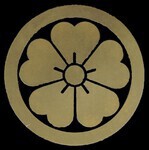
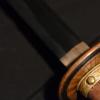
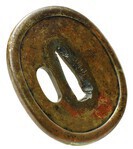

.thumb.jpg.16bf5cc360347306b620b1ae94acfc90.jpg)
.thumb.jpg.882e2ac86c347d73c8b06703fa90a03e.jpg)
.thumb.jpg.29fc3589e7bd887201502ddc0fa88666.jpg)
.thumb.jpg.f7ab98e8d0192625a6c844fbb6e399cf.jpg)
.thumb.jpg.b6c0098032580658ac47fe25205218a6.jpg)
.thumb.jpg.cc44b7ead20cba3b55e8d848183d8924.jpg)
.thumb.jpg.512ab6dc61670f32700697919079c575.jpg)




